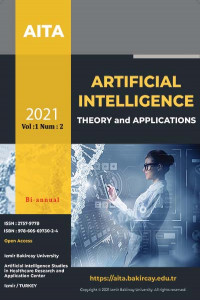Abstract
Patients’ length of stay (LOS) in intensive care units (ICU) is an important factor for managing limited ICU resources such as beds, staffing, medicines, and medical devices. The goal of this study predicts that the ICU length of stay of patients is more than 3 days or not with Support Vector Machine (SVM), Logistic Regression (LR), XGBoost classifiers. We retrieved the 37,600 ICU
patients’ demographics data and last measured vital signs in their first 12 hours of stay from the MIMIC-III database. We filled the missing patients' data with three missing data imputation methods, namely k-nearest neighbor imputation (KNN), multivariate imputation by chained equations (MICE), and SoftImpute. Our results indicated that filling missing data with the Soft-Impute yielded the highest AUC score for all classifiers. We obtained the highest area under the curve score as 66.1% with the XGBoost classifier and Soft-Impute missing data imputation.
References
- [1] Ma, X., Si, Y., Wang, Z., &Wang, Y. (2020). Length of stay prediction for ICU patients using individualized single classification algorithm. Computer Methods and Programs in Biomedicine, 186, 105224. https://doi.org/10.1016/j.cmpb.2019.105224
- [2] Olmez, E., Areta, O., & Er, O. (2021). Classification of Breast Cancer using Artificial Neural Network Algorithms. Artificial intelligence theory and applications,1, 57-68.
- [3] Magesh, P. R., Myloth, R. D., &Tom, R. J. (2020). An Explainable Machine Learning Model for Early Detection of Parkinson's Disease using LIME on DaTSCAN Imagery. Computers in Biology and Medicine, 126, 104041. https://doi.org/10.1016/j.compbiomed.2020.104041
- [4] Akgül, G., Çelik, A., Ergül Aydın, Z., & Kamışlı Öztürk, Z. (2020). Hipotiroidi Hastalığı Teşhisinde Sınıflandırma Algoritmalarının Kullanımı. Bilişim Teknolojileri Dergisi, 13 (3), 255-268. DOI: 10.17671/gazibtd.710728
- [5] Daghistani, T. A., Elshawi, R., Sakr, S., Ahmed, A. M., Al-Thwayee, A., & Al-Mallah, M. H. (2019). Predictors of in-hospital length of stay among cardiac patients: A machine learning approach. International journal of cardiology, 288, 140–147. https://doi.org/10.1016/j.ijcard.2019.01.046
- [6] Triana, A. J., Vyas, R., Shah, A.S., &Tiwari V. (2021). Predicting Length of Stay of Coronary Artery Bypass Grafting Patients Using Machine Learning. Journal of Surgical Research, 264,68-75. https://doi.org/10.1016/j.jss.2021.02.003.
- [7] Maharlou, H., Niakan Kalhori, S. R., Shahbazi, S., & Ravangard, R. (2018). Predicting Length of Stay in Intensive Care Units after Cardiac Surgery: Comparison of Artificial Neural Networks and Adaptive Neurofuzzy System. Healthcare informatics research, 24(2), 109–117. https://doi.org/10.4258/hir.2018.24.2.109
- [8] Thompson, B., Elish, K. O., & Steele, R.(2018). Machine Learning-Based Prediction of Prolonged Length of Stay in Newborns. 17th IEEE International Conference on Machine Learning and Applications (ICMLA), 2018, 1454-1459. doi: 10.1109/ICMLA.2018.00236.
- [9] Harutyunyan, H., Khachatrian, H., Kale, D.C. et al. (2019). Multitask learning and benchmarking with clinical time series data. Sci Data 6, 96 https://doi.org/10.1038/s41597-019-0103-9
- [10] Gentimis, T., Alnaser, A. J., Durante, A., Cook, K. & Steele, R.(2017) Predicting Hospital Length of Stay Using Neural Networks on MIMIC III Data. 2017 IEEE 15th Intl Conf on Dependable, Autonomic and Secure Computing, 15th Intl Conf on Pervasive Intelligence and Computing, 3rd Intl Conf on Big Data Intelligence and Computing and Cyber Science and Technology Congress(DASC/PiCom/DataCom/CyberSciTech), 2017, 1194- 1201, doi: 10.1109/DASC-PICom-DataCom-CyberSciTec.2017.191.
- [11] Johnson, A., Pollard, T., Shen, L. et al. (2016) MIMIC-III, a freely accessible critical care database. Sci Data 3, 160035. https://doi.org/10.1038/sdata.2016.35
- [12] van Buuren, S., & Groothuis-Oudshoorn, K. (2011). mice: Multivariate imputation by chained equations in R. Journal of Statistical Software 45 (3), 1–67,doi:10.18637/jss.v045.i03.
- [13] Mazumder, R., Hastie, T., & Tibshirani, R. (2010). Spectral Regularization Algorithms for Learning Large Incomplete Matrices. Journal of MachineLearning Research, 11 (80),2287–2322.
- [14] Cortes, C., Vapnik, V. (1995). Support-vector networks. Mach Learn, 20, 273–297, https://doi.org/10.1007/BF00994018
- [15] Chen, T., Guestrin, C. (2016). XGBoost. in: Proceedings of the 22ndACM SIGKDD International Conference on Knowledge Discovery and Data Mining, ACM, New York. doi:10.1145/2939672.2939785.
- [16] Liu, J., Wu, J., Liu, S., Li, M., Hu, K. & Li, K. (2021) Predicting mortality of patients with acute kidney injury in the ICU using XGBoost model. PLoS One, 16(2). doi: 10.1371/journal.pone.0246306
- [17] Leung, W. K., Cheung ,K. S. , Li, B., et al.(2021) Applications of machine learning models in the prediction of gastric cancer risk in patients after Helicobacter pylori eradication. Aliment Pharmacol Ther, 53 (8), 864– 872.
- [18] Pang, X., Forrest, C. B., Lê-Scherban, F., Masino, A. J. (2021) Prediction of early childhood obesity with machine learning and electronic health record data. International Journal of Medical Informatics. 150, 104454. https://doi.org/10.1016/j.ijmedinf.2021.104454.
- [19] Wang, S., McDermott, M.B.A., Chauhan, G., Ghassemi, M., Hughes, M.C., Naumann, T., & Ghassemi, M. (2020). Mimic-extract: A data extraction, preprocessing, and representation pipeline for mimic-iii.,Proceedings of the ACM Conference on Health, Inference, and Learning, 222-235. https://doi.org/10.1145/3368555.3384469
Details
| Primary Language | English |
|---|---|
| Subjects | Engineering, Clinical Sciences |
| Journal Section | Research Articles |
| Authors | |
| Publication Date | September 30, 2021 |
| Published in Issue | Year 2021 Volume: 1 Issue: 2 |

